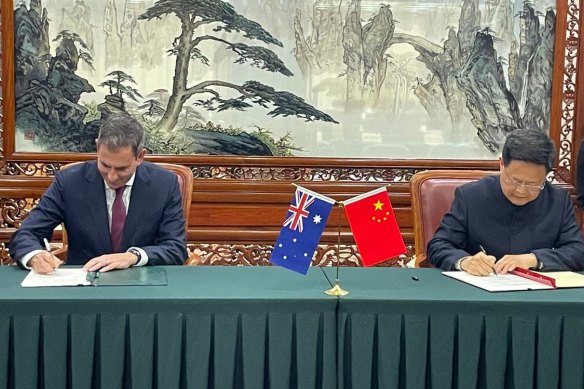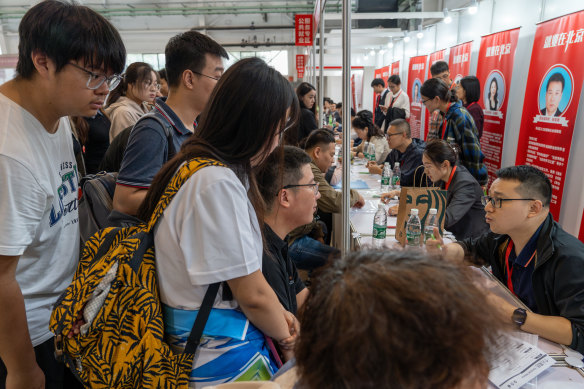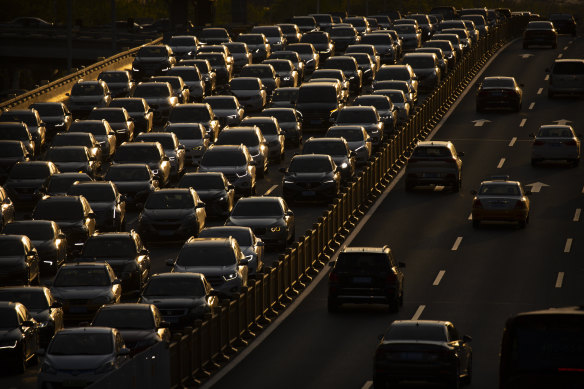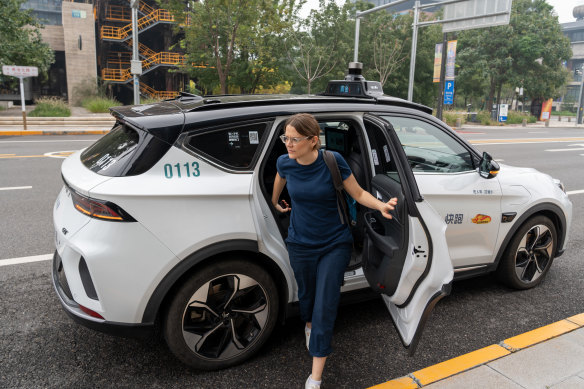- Analysis
- World
- Asia
- Inside China
This was published 6 months ago
Xi’s robocops and driverless cars leaving young people behind
What in the World, a free weekly newsletter from our foreign correspondents, is sent every Thursday. Below is an excerpt. Sign up to get the whole newsletter delivered to your inbox.
I have recently returned from a week-long trip to Beijing after securing a prized ticket that has been sparingly issued to Australian reporters by Chinese authorities for much of the past four years – a short-term journalism visa.
I was there to join a small pack of Australian press covering Treasurer Jim Chalmers’ two-day visit to the Chinese capital for meetings, which doubled as a fact-finding mission of sorts to gauge how severely the country’s economic slowdown will hit Australia.

Jim Chalmers with his Chinese counterpart in Beijing.Credit: Lisa Visentin
For my part, it doubled as an opportunity to get an on-the-ground glimpse of how China’s economy is moving at multiple speeds, as President Xi Jinping attempts to execute his “Chinese-style modernisation” agenda to transform the country into a high-tech superpower.
In Xi’s vision, advanced manufacturing and industries such as clean energy and artificial intelligence will become the job engine room of China’s growth model, while the economy is weaned off its reliance on the collapsing property sector. There are, however, some major hurdles on this path.
At a jobs fair in central Beijing, I spoke with young workers as they filed into an exhibition hall on a Saturday morning resumes in hand, eager to get a foot in the door of one of these industries of the future.
They are facing record levels of unemployment, which peaked at 18.8 per cent this year among 16 to 24-year-olds, according to the National Bureau of Statistics, while a growing malaise among the country’s youth about their future has become a key symptom of its economic rut.

Young job seekers consult with employment advisors at a job fair in Beijing on Setember 28, 2024. Credit: Sanghee Liu
Li Qing, a 27-year-old who was previously employed in the electronics manufacturing sector, has been out of work for two months. She applied for more than 50 jobs in that time, leading to 10 interviews but no final offer.
“The general employment environment is not good, so I have to start thinking about a transition job or alternative job that is not in line with my [university] major and become more flexible,” Li told me.
Another 24-year-old, who gave only her surname, Wang, was hoping to use her accounting degree to segue into a career in data analysis, but was discovering “the number and quality of jobs available is decreasing year by year. The most frequently recruited job is sales.”

Beijing’s famously clogged roads are increasingly dominated by electric vehicles.Credit: AP
This despondency has spawned viral chatter on Chinese social media platforms about living through a “garbage time of history” and the emergence of a “lying flat” movement centred on the idea that young people are better off rejecting a hyper-competitive, poorly paid work culture and embracing other more emotionally fulfilling endeavours.
But amidst this gloomy sentiment, there are plenty of signs in Beijing of an economic transition underway in line with Xi’s vision.
The city’s famous traffic jams are, these days, heavily populated with electric and hybrid cars, including the city’s taxi fleet. For the second month in a row, so-called “new energy vehicles” outsold traditional petrol cars, accounting for 54 per cent of all retail sales in August. By comparison, about one in every four new cars sold in Australia is an EV or hybrid.

North Asia correspondent Lisa Visentin walks out of robotaxi in south Beijing.Credit: Sanghee Liu
In the city’s digital economic heartland known as Beijing E-town, it’s possible to hail a self-driving robotaxi to ferry you cheaply around – similar to the driverless Waymo taxis that cruise San Francisco’s streets – albeit limited to designated zones for now.
At least 19 other Chinese cities are trialling driverless cars. It is this made-in-China autonomous driving technology and car software systems that the Biden administration announced last month it would seek to ban from US roads, citing national security concerns – though the Australian government has already confirmed it will not follow suit.
China’s AI-driven future is also being maximised by its panopticon state, which has police cameras seemingly covering every square centimetre of downtown Beijing and beyond in a vast network of constant surveillance.
At a park near my hotel in central Beijing, a four-wheeled robot is on perpetual patrol, scanning for any disruptive activity to alert authorities. The robocop strikes me as a disconcerting, if not vaguely malevolent presence, though a group of elderly Beijingers practising their morning tai chi seems untroubled.
For now, these advanced tech industries, though burgeoning, are not big enough job-generators to kickstart the floundering economy. That’s before you factor in moves by the US and EU to slap import tariffs of 100 per cent and up to 45 per cent respectively on Chinese EVs, and America’s efforts to strangle Beijing’s access to high-end AI chips.
Xi’s growth model also poses unanswered questions about the role of hundreds of millions of poor rural farmers and migrant workers in the nation’s cutting-edge future, many of whom have flocked to the cities to find work in the now-beleaguered construction industry.
As one migrant worker put it to me: “It is an inspiring goal to move to an advanced society like that, but it is one that will eventually leave people like me jobless.”
Get a note directly from our foreign correspondents on what’s making headlines around the world. Sign up for the weekly What in the World newsletter here.